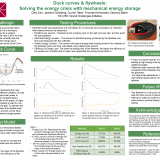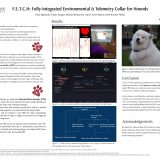
Duck curves & flywheels: Solving the energy crisis with mechanical energy storage Curren Taber, Gary Zeri, Jackson Goldberg, Thomas Hernandez, Zachery Baker
May 11, 2020
For society to transition to a fully renewable power grid without dependence on slowly dwindling fossil fuel energy sources, a means of renewable energy storage is required. Renewable energy production fluctuates pertinent to the time of day, such as in the case of solar power, where large amounts of solar power are generated during the day, but no solar power can be produced at night. Our team’s goal is to re-purpose an older technology known as a flywheel that is used in cars for energy stabilization for storing solar energy overnight. To accomplish our goal, we built a simple proof-of-concept model and gathered data on the flywheel’s energy storage dependence on its mass. Our results demonstrated that energy storage of the flywheel decreased with an increased mass, although general physics would suggest that energy storage should improve with a larger mass. This data provides a stepping stone in the pathway towards being able to completely re-purpose this older technology into a novel method of overnight energy storage to allow for the widespread use of solar and other renewable energy sources.
1st Semester Iteration: The Mop Bucket
2nd Semester Iteration: The Improved Mop Bucket
3rd Semester Iteration: The 3D Printed Flywheel
4th Semester Iteration: Flywheel with Vibration Stabilization & Added Mass


